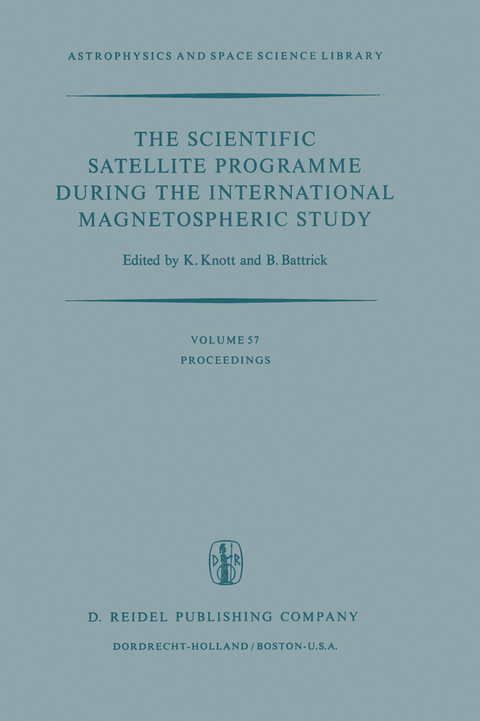
The Scientific Satellite Programme during the International Magnetospheric Study
Springer (Verlag)
978-94-010-1894-4 (ISBN)
1. Opening Session.- A Summary Status Report on the International Magnetospheric Study.- The IMS Satellite Programme: Scientific Objectives.- 2. IMS Satellites: Orbits and Scientific Potential.- Identification of Satellites Possibly Active during the IMS and their Orbital Configurations.- Agreed Plans for Geos Payload Operation and Orbital Manoeuvres.- Present Status of ISEE (A and B) Mission.- The ISEE-C Mission and the IMS.- Diagnosis of Spatial Plasmas with a Relaxation Sounder.- 3. Quasistatic Magnetospheric Phenomena and Particles.- Magnetospheric DC Electric Fields: Present Knowledge and Outstanding Problems to be Solved during the IMS.- Magnetospheric Convection Induced by Interplanetary Magnetic-Field Variations.- Magnetopause Position and the Reconnection Problem.- New Theoretical Aspects of the Shape of the Magnetospheric Boundary.- Low-Energy Heavy-Ion Observations on the IMP 7 Satellite.- Low-Energy-Proton Regime in the Geomagnetic Tail at Lunar Distance.- Solar Phenomena, Weather and Climate.- 4. Particles and Magnetospheric Instabilities.- Multisatellite Observations of Solar Protons Penetrating the Magnetopause.- Trapped Particles and Waves, and What can be Learned from Multisatellite Experiments.- Magnetospheric Dynamics and Wave-Particle Interactions.- Mode Coupling of Cerenkov Radiation as a Source of Noise Above the Plasma Frequency.- Propagation Characteristics of Electromagnetic Waves in the Magnetosphere.- VLF Electrostatic Waves in the Magnetospheres of the Earth and Jupiter.- 5. Substorms and Conjugated Phenomena.- Substorm Phenomena and the Uniqueness of the Geostationary Orbit for Observation of Dynamic Processes in the Magnetosphere.- Substorm Observations of Magnetic Perturbations and ULF Waves at Synchronous Orbit by ATS-1 and ATS-6.- Summary of the La Jolla Conference on Quantitative Magnetospheric Models.- Influence of Magnetospheric Parameters on Geosynchronous Field Characteristics, Last Closed Field Lines and Dayside Neutral Points.- Proposed Ba+ Ion-Tracer Conjugacy and Related Studies Using the Geos Satellite.- 6. Near-Earth Experiments Related to the IMS Satellite Programmes.- Local Acceleration of Auroral Electrons.- Support of Satellite Missions by High-Latitude Rocket Campaigns.- The Roles of Networks of VLF Direction-Finding Receivers during the IMS.- Availability and Distribution of Geos Data during the IMS.- Method, Content and Format of ISEE Data Distribution.- Index of Authors.
| Reihe/Serie | Astrophysics and Space Science Library ; 57 |
|---|---|
| Zusatzinfo | XVI, 464 p. |
| Verlagsort | Dordrecht |
| Sprache | englisch |
| Maße | 178 x 254 mm |
| Themenwelt | Naturwissenschaften ► Physik / Astronomie ► Astronomie / Astrophysik |
| Naturwissenschaften ► Physik / Astronomie ► Elektrodynamik | |
| ISBN-10 | 94-010-1894-4 / 9401018944 |
| ISBN-13 | 978-94-010-1894-4 / 9789401018944 |
| Zustand | Neuware |
| Haben Sie eine Frage zum Produkt? |
aus dem Bereich


